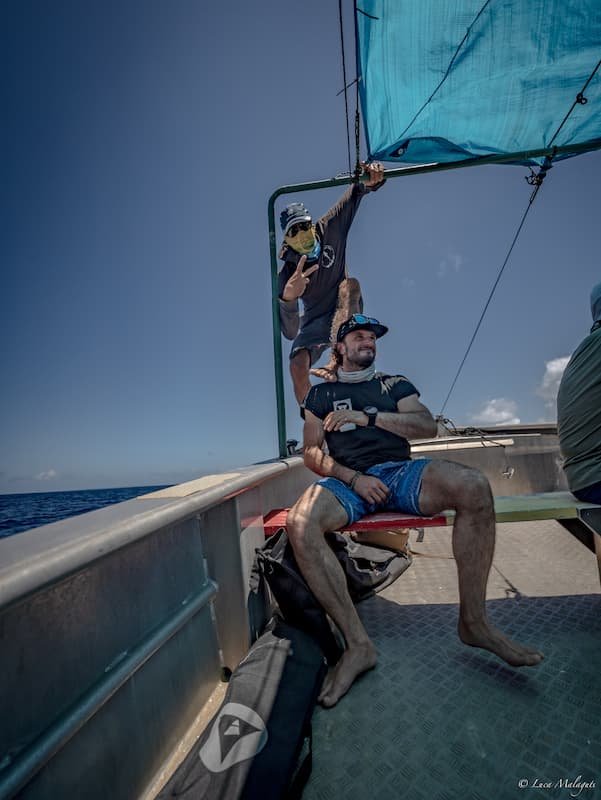Starting the thrilling adventure of deep freediving necessitates more than mere daring; it mandates a groundwork established on learning, ongoing practice, commitment, and steadfast determination. Within this blog post, we'll unveil four crucial pointers to enhance your deep freediving journey.
When embarking on a deep dive, particularly one that not many athletes undertake, employing a counterweight system is advisable. Having such a system ensures a quicker and easier ascent to the surface in case of any unforeseen circumstances at depth. While encountering significant issues at depth is not common, it has occurred, and relying solely on physical strength to assist someone back to the surface can be problematic, especially when tethered by a lanyard.
Therefore, if feasible, utilizing a counterweight system is recommended. Alternatively, if opting not to use a counterweight, employing a double buoy setup is advised. This entails securing knots and equipment to one buoy while attaching another as a backup in case the primary buoy fails. This precautionary measure helps maintain the setup securely in place for a safe deep dive, preventing potential mishaps such as a broken carabiner, a slipped knot, or similar issues. Experiencing equipment failure during a free immersion dive, for instance, where pulling on the rope proves futile, can pose significant risks, as one might be forced to swim to the surface without fins. Such scenarios have been encountered by acquaintances, emphasizing the importance of avoiding them during deep dives to prevent potentially hazardous situations.

Adaptation is a crucial aspect to consider for deep diving, and I have one more tip to offer in this regard. In my experience, there isn't much one can do on dry land to prepare for deep diving apart from stretching exercises to expand lung capacity. However, once in the water, I highly recommend focusing on Full Lung Capacity (FRC) dives and Residual Volume (RV) dives.
Begin by mastering FRC dives before progressing to RV dives. This practice is essential to condition your lungs for the immense pressures experienced during deep dives. Typically, deep dives require significant recovery time afterward. By incorporating numerous FRC or empty lung dives into your routine, you'll enhance your lung capacity and resilience, allowing for repeated exposure to high pressures, potentially even surpassing those encountered during deep dives.
This rigorous training regimen ensures that your lungs are well-prepared for the demands of actual deep dives. Should any tension or issues arise during a dive, your lungs will be equipped to handle them, reducing the risk of lung squeeze or throat injuries. Personally, I dedicated approximately one month to intensive RV dive training when access to deep dives was limited. As a result of this preparation, both physically and mentally, I managed to increase my personal best depth by approximately 10 meters. In my opinion, this method of preparation not only fosters adaptation but also minimizes the likelihood of injury during deep dives.

Another important aspect I'd like to discuss is the risk of over-training, which deep divers must be mindful of and handle with caution. Unlike other sports where a single night's rest can rejuvenate energy levels, freediving requires a different approach due to the accumulation of nitrogen, which significantly impacts our bodies and performance.
In my experience, once I surpass the 80-meter mark, I find it necessary to incorporate rest days into my training regimen. For optimal performance and recovery, I adhere to a schedule of deep diving one day followed by a rest day, and then another day of deep diving.
While some may follow a routine of three consecutive days of diving followed by a day of rest, I recommend taking that extra day off, particularly for deep diving endeavors. This practice not only aids physical recovery but also provides a mental break, preventing the strain of pushing oneself to the limit every day. In my opinion, this approach helps maintain peak performance levels over an extended period.
I've personally maintained peak performance levels for up to two months, consistently achieving dives close to my personal best, thanks to incorporating rest days into my training routine. Therefore, my recommendation to avoid over-training and ensure sustained peak performance is to prioritize adequate rest intervals between training sessions.

Lastly, I'd like to emphasize a fundamental rule that applies to all freedivers: never dive alone. When engaging in deep diving, ensure that your dive buddy is not only capable but also competent in providing safety support. It can be challenging to find individuals proficient in proper safety procedures, and if you find yourself with freedivers who may not meet the necessary criteria, I strongly advise against proceeding with deep dives. Entrusting someone with safety responsibilities whose personal best is significantly lower than the intended dive depth poses risks to all involved.
Always strive to find a dive buddy who is either at your skill level or close to it, or at the very least, someone for whom safety is a top priority. Deep diving inherently carries risks, and having a reliable companion nearby can be crucial in case assistance is needed. This concludes the tips I have to offer. I hope you found this video helpful. Until next time, take care, and farewell.